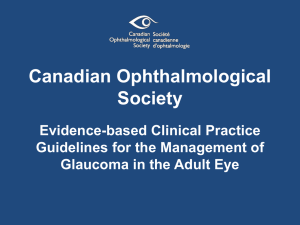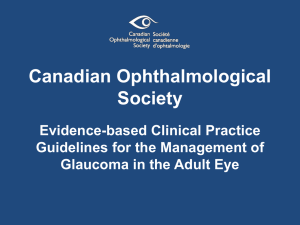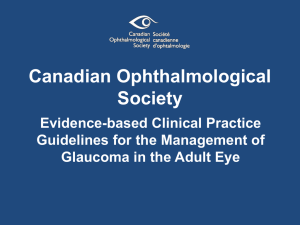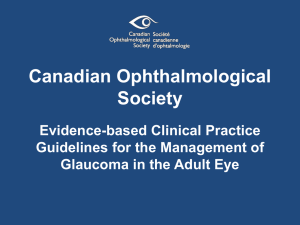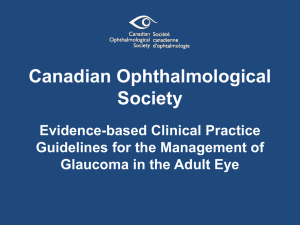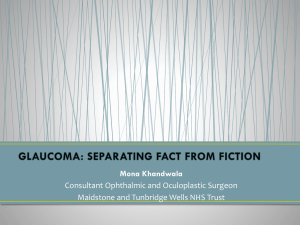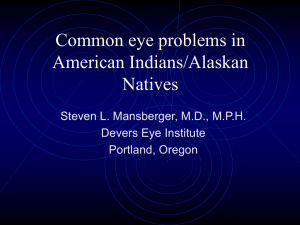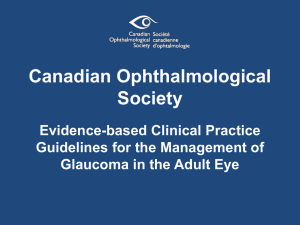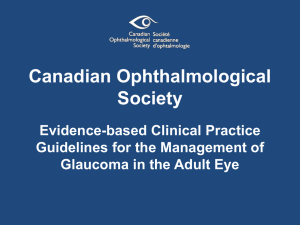Open-angle glaucomas - Canadian Ophthalmological Society
advertisement
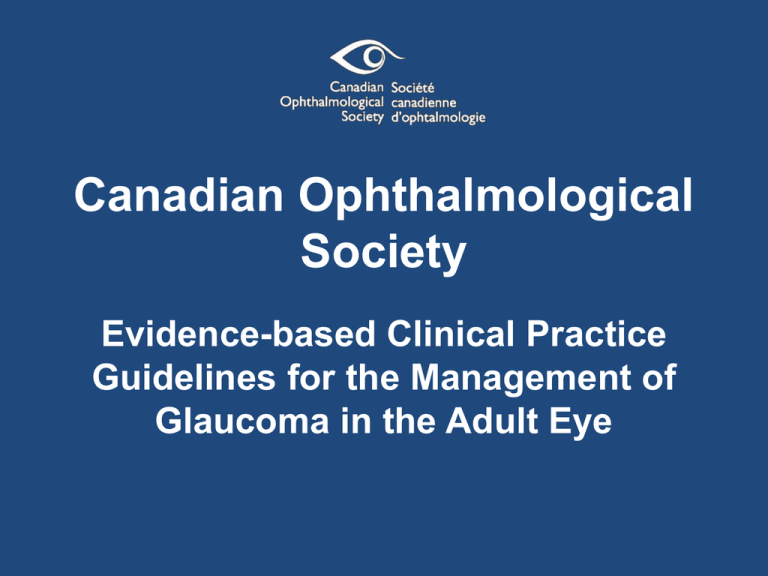
Canadian Ophthalmological Society Evidence-based Clinical Practice Guidelines for the Management of Glaucoma in the Adult Eye Open-angle Glaucoma: Primary Open-Angle Glaucoma Suspects Glaucoma suspects — risk factor monitoring Recommendation A glaucoma suspect with any number of wellestablished risk factors should be monitored for the development of glaucoma [Level 11]. 1. Gordon MA, et al. Arch Ophthalmol 2002;120:714–20. Canadian Ophthalmological Society evidence-based clinical practice guidelines for the management of glaucoma in the adult eye. Can J Ophthalmol 2009;44(Suppl 1):S1S93. Normal Pressure Glaucoma Normal pressure glaucoma (or POAG at normal IOPs) • IOP associated with POAG is usually elevated above the normal distribution (i.e. >21 mm Hg). • However, when the IOP is not elevated, it is often referred to as normal tension glaucoma or NPG. Canadian Ophthalmological Society evidence-based clinical practice guidelines for the management of glaucoma in the adult eye. Can J Ophthalmol 2009;44(Suppl 1):S1S93. Normal pressure glaucoma (or POAG at normal IOPs) • The pathogenesis of NPG remains controversial, but it is: – associated with a higher prevalence of vascular disease and migraine, – more common in older individuals, especially those over age 55 years, – more common in women than in men,1 and – more common in the Japanese population compared with other ethnic groups.2 1. Collaborative Normal-Tension Glaucoma Canadian Ophthalmological Society evidence-based clinical Study Group. Am J Ophthalmol 1998;126:487–97. practice guidelines for the management of glaucoma in the 2. Shiose Y, et al. Jpn J Ophthalmol 1991;35:133–55. adult eye. Can J Ophthalmol 2009;44(Suppl 1):S1S93. Natural history of NPG • The natural history of NPG was evaluated in the CNTGS during the time interval before randomization and in those patients assigned to not receive treatment.1 • Approximately one-third of untreated patients showed confirmed localized VF progression at 3 years. • Approximately one-half showed further deterioration at 7 years. • The change was typically small and slow, often insufficient to measurably affect the mean deviation index. 1. Collaborative Normal-Tension Glaucoma Study Group. Am J Ophthalmol 1998;126:487–97. Canadian Ophthalmological Society evidence-based clinical practice guidelines for the management of glaucoma in the adult eye. Can J Ophthalmol 2009;44(Suppl 1):S1S93. Natural history of NPG (cont’d) • There was tremendous variability in progression rates, with women and individuals with higher IOP, migraines or disc hemorrhages having a greater risk of progression.1 • Overall, a 30% reduction in IOP was effective in reducing the progression in a greater proportion of patients, compared with those receiving no treatment. • While 35% of the control group progressed compared with 12% of the treatment group, it would hold that 65% of the untreated group did not progress during the study period. 1. Collaborative Normal-Tension Glaucoma Study Group. Am J Ophthalmol 1998;126:487–97. Canadian Ophthalmological Society evidence-based clinical practice guidelines for the management of glaucoma in the adult eye. Can J Ophthalmol 2009;44(Suppl 1):S1S93. NPG and treatment Recommendation NPG is a diagnosis of exclusion and therapy does not need to be initiated unless there are significant risk factors and signs of progression, or if fixation is threatened at diagnosis [Level 11]. 1. Anderson DR, et al. Ophthalmology 2001;108:247–53. Canadian Ophthalmological Society evidence-based clinical practice guidelines for the management of glaucoma in the adult eye. Can J Ophthalmol 2009;44(Suppl 1):S1S93. Pigmentary Glaucoma Pigmentary glaucoma • Pigmentary glaucoma is a secondary form of open-angle glaucoma produced by pigment dispersion in the anterior segment of the eye. • It constitutes 1% of the glaucomas seen in many Western countries. • There is a strong association between pigmentary glaucoma and moderate myopia. Canadian Ophthalmological Society evidence-based clinical practice guidelines for the management of glaucoma in the adult eye. Can J Ophthalmol 2009;44(Suppl 1):S1S93. Pigmentary glaucoma (cont’d) • Features of pigmentary glaucoma consist of: – a rise of IOP with optic nerve damage and/or VF loss, and characteristics of pigment dispersion. – There might be: • anisocoria and heterochromia in the affected eye, • lattice degeneration of the retina, with clumps of pigment scattered at the base of the lattice, • retinal pigment epithelial dysfunction, • increased risk of retinal detachment (in up to 6% of patients with pigment dispersion).1 1. Greenstein VC, et al. Arch Ophthalmol 2001;119:1291–5. Canadian Ophthalmological Society evidence-based clinical practice guidelines for the management of glaucoma in the adult eye. Can J Ophthalmol 2009;44(Suppl 1):S1S93. Pigmentary glaucoma (cont’d) • The probability of converting from pigment dispersion to pigmentary glaucoma is fairly low (10% at 5 years and 14% at 15 years).1 • The major risk factor for developing glaucoma is an initial IOP of ≥21 mm Hg at presentation. 1. Siddiqui Y, et al. Am J Ophthalmol 2003;135:794–9. Canadian Ophthalmological Society evidence-based clinical practice guidelines for the management of glaucoma in the adult eye. Can J Ophthalmol 2009;44(Suppl 1):S1S93. Treatment of pigmentary glaucoma • Medical, laser, and surgical options are similar to those used to treat POAG. Canadian Ophthalmological Society evidence-based clinical practice guidelines for the management of glaucoma in the adult eye. Can J Ophthalmol 2009;44(Suppl 1):S1S93. Laser iridotomy and pigmentary glaucoma Recommendation It is recommended that laser iridotomy not be routinely employed in the management of pigmentary glaucoma [Level 21,2]. 1. Reistsad CE, et al. J Glaucoma 2005;14:255–59. Canadian Ophthalmological Society evidence-based clinical 2. Gandolfi SA, et al. Ophthalmology 1996; practice guidelines for the management of glaucoma in the 103:1693–5. adult eye. Can J Ophthalmol 2009;44(Suppl 1):S1S93. Laser trabeculoplasty — IOP monitoring Recommendation It is recommended that IOPs be checked within a few hours post-laser trabeculoplasty, especially in the presence of pigment dispersion because of the higher risk of IOP spikes [Level 11]. 1. Glaucoma Laser Trial Research Group. Arch Ophthalmol 1989;107:113542. Canadian Ophthalmological Society evidence-based clinical practice guidelines for the management of glaucoma in the adult eye. Can J Ophthalmol 2009;44(Suppl 1):S1S93. Pseudoexfoliation Syndrome and Glaucoma PXF syndrome and glaucoma • PXF syndrome: – Is the most common identifiable cause of open-angle glaucoma worldwide.1 – Is a disease of elastic tissue in the posterior chamber of the eye and other systemic sites.2 – Is more common in older age groups, with most cases occurring in people in their late 60s and early 70s.3 – May be unilateral or bilateral at presentation, and many unilateral cases become bilateral with time. – Is more prevalent in Eastern Mediterranean and Northern European countries. 1. Ritch R. Trans Am Ophthalmol Soc 1994;92:845–944. 2. Ritch R, et al. Prog Retin Eye Res 2003;22:253–75. 3. Conway RM, et al. Clin Experiment Ophthalmol 2004;32:199–210. Canadian Ophthalmological Society evidence-based clinical practice guidelines for the management of glaucoma in the adult eye. Can J Ophthalmol 2009;44(Suppl 1):S1S93. PXF syndrome and glaucoma • When PXF is accompanied by elevated IOP and VF and/or disc damage, it is termed PXF glaucoma. • The percentage of PXF patients with glaucoma is different for every population. • About 25% of persons with PXF have elevated IOP, and one-third of these have glaucoma.1,2 1. Ritch R, et al. Surv Ophthalmol 2001;45:265–315. Canadian Ophthalmological Society evidence-based clinical practice guidelines for the management of glaucoma in the 2. Conway RM, et al. Clin Experiment Ophthalmol adult eye. Can J Ophthalmol 2009;44(Suppl 1):S1S93. 2004;32:199–210. PXF syndrome and treatment Recommendation Close monitoring and aggressive IOP-lowering therapy are indicated in patients with PXF glaucoma due to their greater tendency to present IOP spikes, greater 24-hour IOP fluctuations, and their relatively worse prognosis compared with patients with POAG [Level 21]. 1. Leske MC, et al. Ophthalmology 2007;114:1965–72. Canadian Ophthalmological Society evidence-based clinical practice guidelines for the management of glaucoma in the adult eye. Can J Ophthalmol 2009;44(Suppl 1):S1S93.

